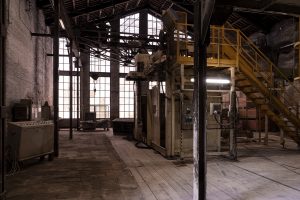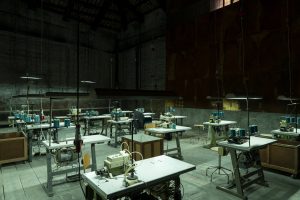On 21 April, on time, I get in line to enter the Biennale: I decided to start from the Arsenale and I have a very good reason to start right here. There are several bad moods for this year’s Italian Pavilion. It is curated by Eugenio Viola, and it exposes works by Gian Maria Tosatti. He is an artist, but he is also the director of Rome’s Quadriennale and he will soon have a solo show at the Pirelli HangarBicocca in Milan. In short, he is almost everywhere in this period, and there are many rumors about him, so I want to understand the reason why. I must be honest, before entering the pavilion I promised myself not to listen to the various discontent or gossip, I must immerse myself in this Bienniale looking at it with the eyes of a child.
I find myself in front of the Italian Pavilion. A Dante line divides us. When my turn arrives, I have such a high hype and I asked to the security men what they think of the Italian Pavilion. Their answer is: “We’ve never seen something like it, it takes you inside”. The entrance to the pavilion is one by one, waiting some minutes between the various persons. This time frame is desired, it serves to enjoy the spaces and if you want some advice, avoid going there in a group and if you can, stay away from those you will meet inside.
The Pavilion is a two-part act: one story that concerns us as mankind and other one concerns nature. The title of our national pavilion is History of the Night and Destiny of Comets.
From the outside, the pavilion recalls the Italian industrial age of 60s and 70s warehouses, an opening for what awaits us in the first part of the pavilion. Inside, I find myself immersed in those years, even the air has the same taste and I wander between the machines. I am so immersed in this scenography that I have the feeling of having to stamp the card to start my work. Everything is perfectly placed, just the staircase makes us go back to reality. It takes the visitor to the top of the pavilion. I have the feeling that this place is real so much is it reproduced well.
Another tip: if you turn around the machinery, you will find different objects that will tell you about a historical and significant period of our country and, at the end, you will find a turntable. Insert the needle on the record to let yourself be accompanied by the music.
On the first floor there is a room with a bed without a mattress, a crucifix on the wall, windows overlooking the ground floor of the textile factory. The second door takes you to the ground floor where you will find the stations of the industrial sewing machines, those that have been used by men and women. If you decide to stay upstairs for a few minutes, I recommend you to put your ear on the walls and to listen.
We end up in a sort of small port where the stormy sea can recall the biblical episode of the universal flood, accompanied by flashes of light in the distance. The whole Italian Pavilion offers a vision of the current state of humanity and its prospects. The work is configured as an intermediary device that contains within itself and blends a plurality of languages from literary references to the visual arts, from theater to music and performance, as Gian Maria Tosatti has accustomed us. A particular and complex experiential narrative machine that leads the audience along a path, at times familiar and at times unsettling, with the aim of offering a new awareness and generating concrete reflections on the possible destiny of human civilization, poised between dreams and errors of the past and the promises of a future that is still partly to be written.
This whole journey is a real experience and when I leave the pavilion with the sunlight caressing me, I have the physical and psychological sensation of feeling like when it rains outside, and you are without an umbrella. You feel fine but also of nostalgic and sad. I came out of the Italian Pavilion which I consider to be one of the most beautiful in the last fifteen years, with precisely this feeling of lightness and a desire to build a future different from what it has been. Probably the Viola/Tosatti duo struck a billiard shot of those impossible, but real, tangible. In some ways it is the most beautiful pavilion ever that I have seen in this Biennale d’Arte edition and, in my opinion, it deserved to win the price of the lagoon festival.
Info:
Storia della Notte e Destino delle Comete
Eugenio Viola – Gian Maria Tosatti
23 april – 27 november 2022
Biennale Arte 2022
 Gian Maria Tosatti, “Storia della Notte e Destino delle Comete”, Padiglione Italia, Biennale Arte 2022, a cura di Eugenio Viola, Commissario del Padiglione Italia Onofrio Cutaia. Courtesy DGCC – MiC
Gian Maria Tosatti, “Storia della Notte e Destino delle Comete”, Padiglione Italia, Biennale Arte 2022, a cura di Eugenio Viola, Commissario del Padiglione Italia Onofrio Cutaia. Courtesy DGCC – MiC
 Gian Maria Tosatti, “Storia della Notte e Destino delle Comete”, Padiglione Italia, Biennale Arte 2022, a cura di Eugenio Viola, Commissario del Padiglione Italia Onofrio Cutaia. Courtesy DGCC – MiC
Gian Maria Tosatti, “Storia della Notte e Destino delle Comete”, Padiglione Italia, Biennale Arte 2022, a cura di Eugenio Viola, Commissario del Padiglione Italia Onofrio Cutaia. Courtesy DGCC – MiC
 Gian Maria Tosatti, “Storia della Notte e Destino delle Comete”, Padiglione Italia, Biennale Arte 2022, a cura di Eugenio Viola, Commissario del Padiglione Italia Onofrio Cutaia. Courtesy DGCC – MiC
Gian Maria Tosatti, “Storia della Notte e Destino delle Comete”, Padiglione Italia, Biennale Arte 2022, a cura di Eugenio Viola, Commissario del Padiglione Italia Onofrio Cutaia. Courtesy DGCC – MiC
 Gian Maria Tosatti, “Storia della Notte e Destino delle Comete”, Padiglione Italia, Biennale Arte 2022, a cura di Eugenio Viola, Commissario del Padiglione Italia Onofrio Cutaia. Courtesy DGCC – MiC
Gian Maria Tosatti, “Storia della Notte e Destino delle Comete”, Padiglione Italia, Biennale Arte 2022, a cura di Eugenio Viola, Commissario del Padiglione Italia Onofrio Cutaia. Courtesy DGCC – MiC

Independent artist and curator. Founder of No Title Gallery in 2011. I observe, study, ask questions, take informations and live in contemporary art, a real stimulus for my research.






NO COMMENT